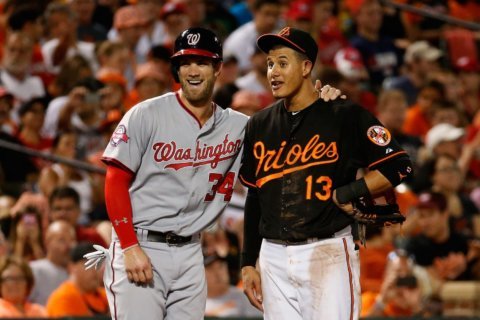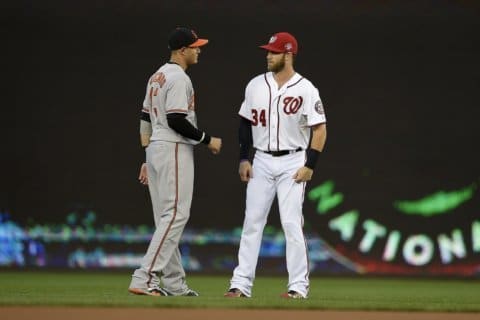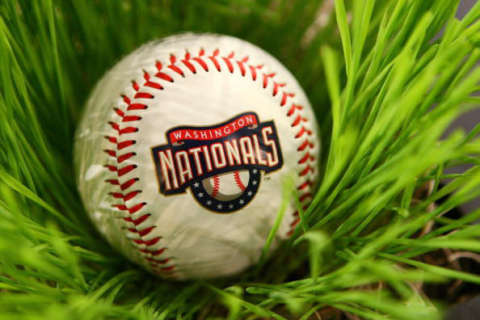It’s not a surprise that the Washington Nationals will report to Spring Training over the next six days without Bryce Harper. What’s surprising is that there’s still a chance he might join them.
As Nats pitchers and catchers file into West Palm Beach Wednesday morning, Harper is still without a team for the 2019 season and beyond. And while the club has attacked the offseason as aggressively as any team in baseball in preparation for his likely departure, there is still some nonzero chance that Harper could return to the District. Whether he does or not will have ripple effects on the roster not just this year, but for the duration of his contract; not just in the outfield, but all around the diamond.
Harper signs elsewhere
Of the five teams that BetOnline listed earlier this week as favorites to land Harper, the Nats were last, at 10-1 odds. While that’s not nothing, the odds — literally — point to him landing elsewhere.
At this point, it seems almost certain that if Harper is in another uniform this season, he will remain in the National League (the four other teams listed were all NL squads). Whether or not he ends up with the Philadelphia Phillies, the National League East ought to provide a good deal of competition. The defending division champion Atlanta Braves won eight more games than the Nats last year, while the Phillies have added coveted catcher J.T. Realmuto and shortstop Jean Segura in trades, along with free agent veteran outfielder Andrew McCutchen and reliever David Robertson. The Mets, when healthy, will still be a nuisance, especially with their strong rotation.
As of right now, Baseball Prospectus’s PECOTA projections have the Nats at 89 wins, the Mets at 88, and both the Braves and Phillies at 85. Rotochamp has the Nats at 90, the Mets 88, the Phillies 85 and the Braves 82 wins. Needless to say, with projections as tight as those, any number of factors could turn those outcomes on their head, regardless of Harper’s final destination. But they ought to be competitive.
Adam Eaton’s return alongside top prospect Victor Robles and Rookie of the Year runner-up Juan Soto gives Washington a full outfield already, if everyone can stay healthy. The infield looks largely the same as it did last year, just with Brian Dozier in Daniel Murphy’s spot at second base. The rotation is stronger at the front with Patrick Corbin in the three spot and the bullpen now includes Trevor Rosenthal.
In all, this is a team that will be unquestionably weaker without Harper, but that has fortified itself around the edges to mitigate at least some of that impact. And remember — Sports Illustrated picked last year’s Nats to win the World Series (again). While some of the faces are different, the overall talent level of this year’s club doesn’t appear very far off on paper from last year’s model.
By not bringing Harper back, the club’s payroll sits somewhere in the vicinity of $195 million, or about $11 million under the ever-looming luxury tax. If ownership is dead set on getting under that threshold this season to reset the various penalties associated with surpassing it, that still leaves some wiggle room to take on salary at the trade deadline, should the club need to add a couple pieces.
Looking beyond 2019, without Harper, extending Anthony Rendon looks to be a lot more feasible. Despite an injury-plagued 2015 campaign, Rendon has averaged better than 4 WAR per season over the last five years, outpacing Harper. Rendon will also be 29 when he hits free agency, which is a double-edged sword: while he’ll have fewer years of his prime remaining, he also likely won’t be looking for nearly the same length contract as Harper has been seeking.
Both in the short and long term, the Nats seem primed to remain competitive without Harper. Eaton has a pair of team options stretching through the 2021 season, while Soto and Robles are under team control for years to come. But, of course, any team could use a Bryce Harper, as the Nats know better than anyone.
Harper re-signs with Washington
Aside from the scramble to add to the promotional schedule and reshuffle the marketing plan, the most immediate impact of Harper’s return to D.C. would likely be to push the Nats to prohibitive front-runner status in the division once again. There would be pressing questions of how to handle the sudden logjam in the outfield, which might prompt some creative shuffling from the dugout.
It would also blow the team’s payroll right through the luxury tax threshold not just in 2019, but likely for years to come. As that is calculated by annual average value, even a heavily deferred deal would impact the bottom line in unavoidable ways.
The Nationals are already nearing $200 million in contract value spent toward the luxury tax in 2019. And while Ryan Zimmerman will finally come off the books (with a buyout) at season’s end, the Nats will have roughly $75 million per year committed to their top three starting pitchers alone each of the next two years. With Rendon set to hit free agency this winter, any future that includes either Rendon or Harper wearing the curly W seems to preclude the other.
Farm system-wise, the Nats have been preparing a backup plan for years in the outfield, but aren’t nearly as Major League ready with a left side infield replacement. Carter Kieboom and Luis Garcia both look primed to be potential in-house replacements at third base (or second, for Kieboom), especially with Trea Turner ensconced at shortstop at the big league level. But Kieboom has played just 62 games at Double-A, where he was just all right last year and Garcia, while highly touted, won’t turn 19 until May and hasn’t played above Low-A Hagerstown. Keeping Harper instead of Rendon could precipitate a trade for some support at the hot corner.
It’s impossible to say exactly what a Harper contract would look like at this point, except that it would likely be for a good number of years at a high AAV that would constrain the flexibility of the front office moving forward. The landscape beyond the 2021 season is even harder to predict, given the almost certain fundamental changes coming to the collective bargaining agreement in the wake of the free agent contract droughts of the last two offseasons. Because of that, it wouldn’t be surprising to see any Harper contract include an opt-out during that time period.
If he stays in Washington for the bulk or the entirety of the rest of his career, though, he has the chance to become the player with which the franchise will be associated for years to come. That would shape the next era of Nationals baseball in an entirely different way than a future without him.







